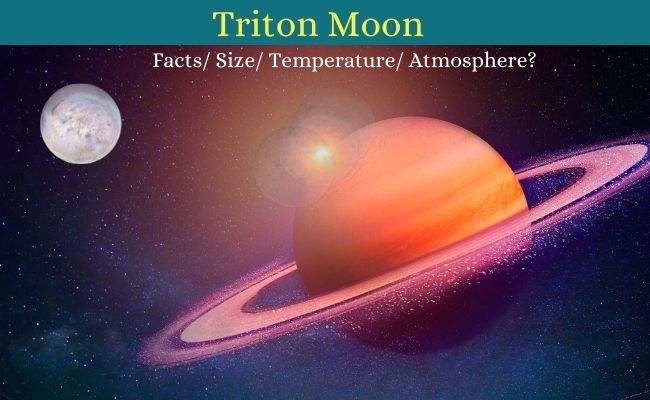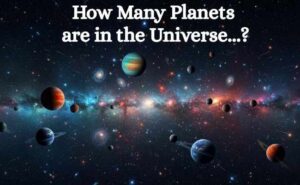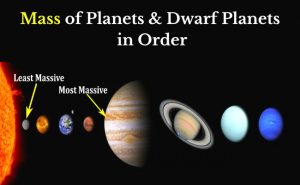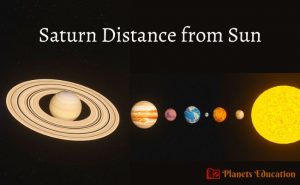Neptune’s moon Triton is the seventh-largest moon in our solar system. Planet Neptune has 14 moons, with which Triton is the biggest. Triton was the very first discovered Neptunian moon and it was discovered on 10 October 1846 by an English astronomer William Lassell.
The orbital motion of the Triton is the opposite of Neptune’s axial rotation. So, it is the only large moon in our solar system that has a retrograde orbit. According to its orbital distance from Neptune, it is the eighth moon. The average distance of the Triton satellite from Neptune is around 354760 km (220,438 mi).
Check About:- Neptune Planet Facts and Information
Facts of Triton Moon
Triton is one of the farthest and largest moons. Below is some interesting information and Triton Moon Facts.
Triton is slightly smaller than Our Moon
Neptune’s moon Triton is slightly smaller than Our Moon (earth’s moon). The size of the Triton satellite is around 2708 kilometers (1680 mi) in diameter. Whereas the earth’s moon diameter is around 3475 km (2159 mi).
Triton is larger than even our former 9th planet Pluto. And it is the only satellite of Neptune that is large and massive enough to be in hydrostatic equilibrium.

If Triton were not orbiting any planet, it would have itself considered a planet.
It is a very cold world
Triton is one of the farthest large worlds. No other object is larger than it in our solar system, which has crossed its orbit’s distance. Because it is very far, it receives very little solar radiation. The triton moon distance to earth and sun is around 30 AU. It is quite a cold and large world.
The surface temperature of Triton is around 36K (−237°C). Like earth, it has a core, mantle, and crust. But this satellite has totally icy crust.
Its south polar cap is covered with ice (frozen nitrogen) confirmed by Voyager 2. According to scientists, the north pole is also covered with the ice cap but Voyager 2 didn’t confirm the ice caps, because it was on the dark side.
It has frozen nitrogen
Triton’s south and north pole have ice caps. Around 55% of its surface is covered with frozen nitrogen, of which 35% is water ice and almost 20% is frozen CO2 (dry ice). With help of Voyager 2, only 40% of its surface is observed. But scientists believe the whole surface is covered with nitrogen ice.
The only large moon with retrograde motion
Neptune’s Triton is the only moon in our solar system that has a retrograde motion direction. It means the orbital direction of this satellite is opposite to Neptune’s axial motion.
Must Read:- Revolution of Planets Around the Sun
It is a tidally locked moon
Like many other satellites, Triton is also a tidally locked satellite. It means, it took the same time to complete one orbit around Neptune as it takes to complete one revolution around its own axis. This is why the one day and one year are the same on the Triton. The one day and one year on Triton moon are around 5.87 days (5 days 21 hours).
Must Check:- How Long is a Day and Year on each Planet?
It has active geysers of high altitude
Triton’s icy surface has many impact craters, cryovolcanic terrains, tectonic terrains, and geysers. On the Triton satellite, Geysers are the eruption of water, ammonia, methane in form of a volatile state. According to scientists, geysers on this moon reach up to as high as 8 kilometers. These eruptions of geysers are mostly in form of sublimated nitrogen and methane gas. This is why Triton has a nitrogen-filled atmosphere.
Its orbital eccentricity is almost zero
Most of the objects of our solar system that orbit any other object have some orbital eccentricity. But the orbital path of Triton is on a circle around Neptune. It has almost zero eccentricity. Mathematically the eccentricity of the Neptune’s moon Triton is 0.000016, which is very very less compared to other well-known objects in the solar system.
Triton will break and make a ring around Neptune
According to scientists, Triton will decay the orbital distance and will come near Neptune. And around 3.5 billion years either it will collide with Neptune or break apart itself. The breaking apart of Triton will form a ring system around Planet Neptune that would be very similar to Saturn’s ring system.
Voyager 2 is the only spacecraft to visit it
Triton is one of the farthest well-known moons of our solar system. Voyager 2 was a spacecraft launched in 1977 by NASA to explore the outer planets of the solar system. It approaches close flyby to Triton in 1989. During its visit, it took some images and help scientists to find more accurate data of Neptune’s moon Triton. Till now, Voyager 2 is the only space probe to approach near this world.
Characteristics of Triton Moon:-
- Orbital period (1 year): 5 days 21 hours
- Revolution period (1 day): 5 days 21 hours
- Average orbital speed: 4.40 km/sec around Neptune
- The average distance from Neptune: 354760 kilometers (220,438 mi)
- Mean radius: 1354 km
- Mass: 2.14 × 1022 kg
- Volume: 1.04 × 1010 km3
- Average density: 2.06 gm/cm3
- Surface gravity: 0.78 m/sec2 (0.079 times of earth)
- Escape velocity: 1.45 km/sec
- Average surface temperature: 38K (−235°C)
- How Many Planets Exist in the Universe — A Cosmic Estimate
- 5 Best Solar System Backpacks in 2025
- Mass of Planets in Order from Lightest to Heaviest
- Star Projector {2025}: Star Night Light Projector
- Saturn Distance from Sun – How Far is Planet Saturn?
- Planet Books: Books about Planets (All Aged Kids)






